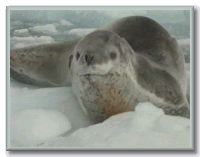|
The Leopard seal, Hydrurga leptonyx, is another familiar seal of the pack ice. However, it may be most conspicuous when hunting penguins near a rookery. It is the largest of the true Antarctic seals. The females measure up to 3.4m with an easily recognizable outline-a somewhat reptilian head, a sinuous neck and a highly-arched thorax. Its very long fore-flippers are also characteristic.
|
The Leopard Seal, like the Crabeater, has very complicated teeth, equally well adapted to straining krill or catching active prey such as fish or penguins. However, about two-fifths of their diet consists of the flesh of warm-blooded animals, birds (mostly penguins), other seals (usually young Crabeaters), and occasional carrion; about the same proportion is krill. Smaller quantities of fish, squid, and other invertebrates are also taken. (You'll see a Leopard seal killing an unfortunate Adelie by flipping it from side to side on the ocean surface in program 5!)
|
|
|
WANT TO LEARN MORE?
|
|
Websites
• Leopard Seals Information on the Leopard seal including taxonomy. • Seals Links to information on the Crabeater, Elephant, Antarctic Fur, Leopard and Weddell seals. |
![]()

